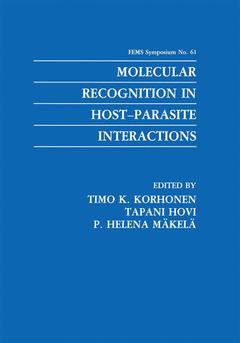Description
Molecular Recognition in Host-Parasite Interactions, 1992
F.E.M.S. Symposium Series, Vol. 61
Coordinators: Korhonen Timo K., Hovi Tapani, Mäkelä P. Helena
Language: English
Subjects for Molecular Recognition in Host-Parasite Interactions:
Keywords
Cytosol; Pathogene; bacteria; bacterial pathogenesis; infection; microbe; protein; virus; infectious diseases
Publication date: 12-2012
230 p. · 17.8x25.4 cm · Paperback
230 p. · 17.8x25.4 cm · Paperback
Description
/li>Contents
/li>
A very early step in microbial colonization and pathogenesis is that involving recog nition of the host by the microbe. In the final analysis such recognition is due to interaction between specific molecules on the two sides, without which host and microbe would ignore each other. It is therefore exciting to learn the rules that govern host-microbe interaction at to a large extent determines whether or not we are infected by the molecular level, which influenza virus, leishmanias, staphylococci and other pathogens. This book is a compendium of the addresses delivered at a symposium on molecular interaction at Porvoo, Finland in August 1991. Realizing that there are no a priori differ ences in receptor recognition in viruses, eukaryotic parasites and bacteria, we freely inter mingled these microbes at the symposium, and in this book. We found the interdisciplinary discussions and comparisons both educative and stimulating. Thus the book is divided into parts that focus on host cell receptors, on microbial recognition molecules and molecules that mediate microbial interaction with a host cell receptor and, briefly, on the molecular events that follow. Although many microbes and many cellular receptors are missing from the book -owing to the limited duration and size of the symposium -the articles presented here constitute an impressive body of examples of how initial host-microbe interaction can come about. We believe that as such the book is a useful and interesting overview of the mechanisms and principles involved in these interactions.
Microbial Components in Recognition: Streptococcal M Protein V.A. Fischetti, et al. Properties and Synthesis of K88 Fimbriae; F.K. de Graaf, D. Bakker. SLayers in Bacterial Pathogenesis; T.J. Trust, W.W. McKay. Minifunctional Nature of Enterobacterial Fimbriae; T.K. Korhonen. Host Components in Recognition: Virus Interaction with Host Cell Receptors; E. Hounsell, et al. Role of Cell Receptors for Poliovirus in Pathogenesis, Host Range, and Virus Entry; V.R. Racaniello, et al. Membrane Proximity and Internal Binding in the Microbial Recognition of Host Cell Glycolipids; K.A. Karlsson, et al.Host Cell Invasion: Inhibitory Action of Amantadine during Viral Entry; K. Martin, et al. Effect of Host Proteases on Early Steps of Enterovirus Infection; T. Hovi, et al. Protein Translocation from the Exterior to the Cytosol; S. Olsnes. 13 additional articles. Index.
© 2024 LAVOISIER S.A.S.
These books may interest you

Genes Involved in Plant Defense 52.74 €



